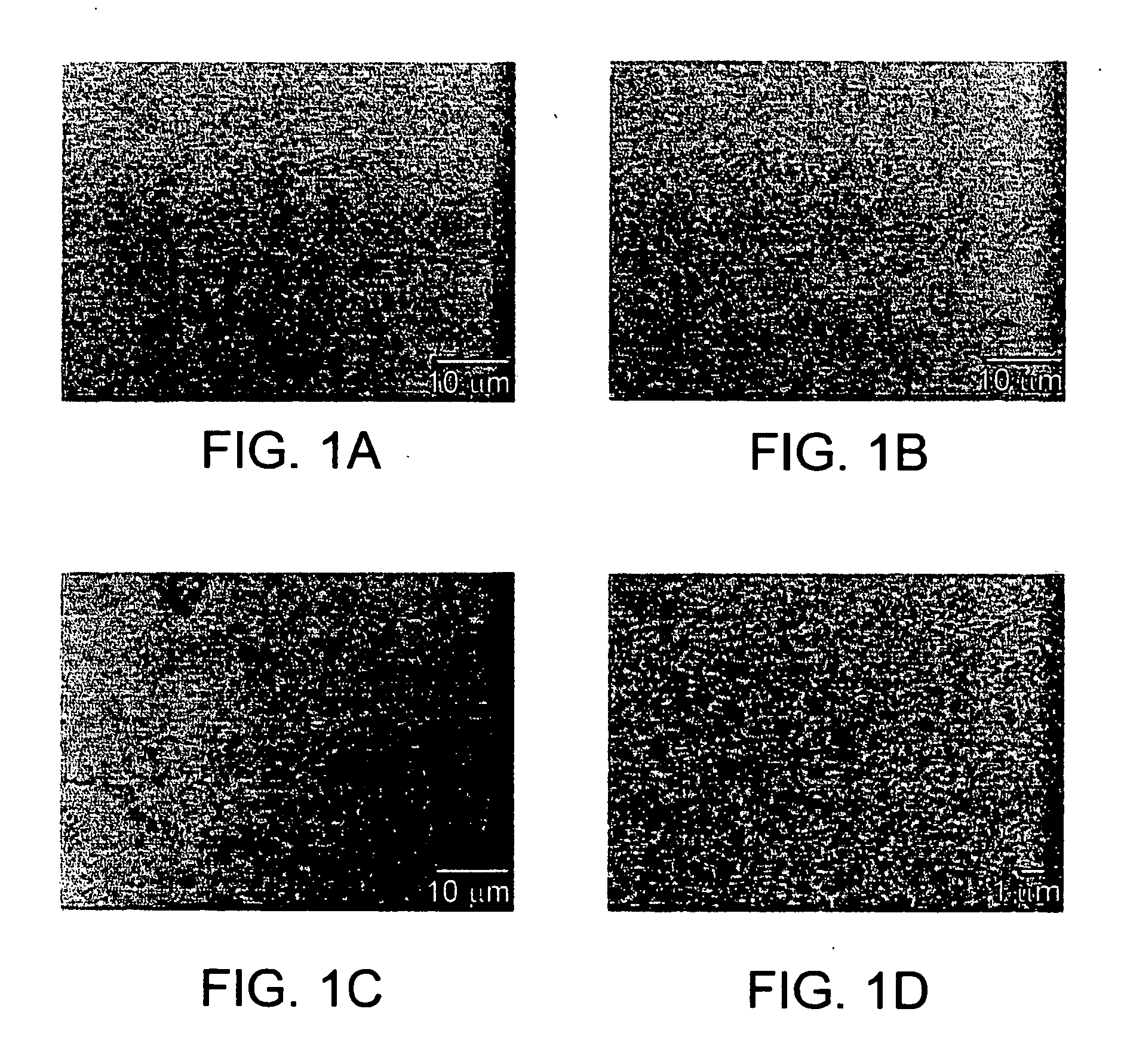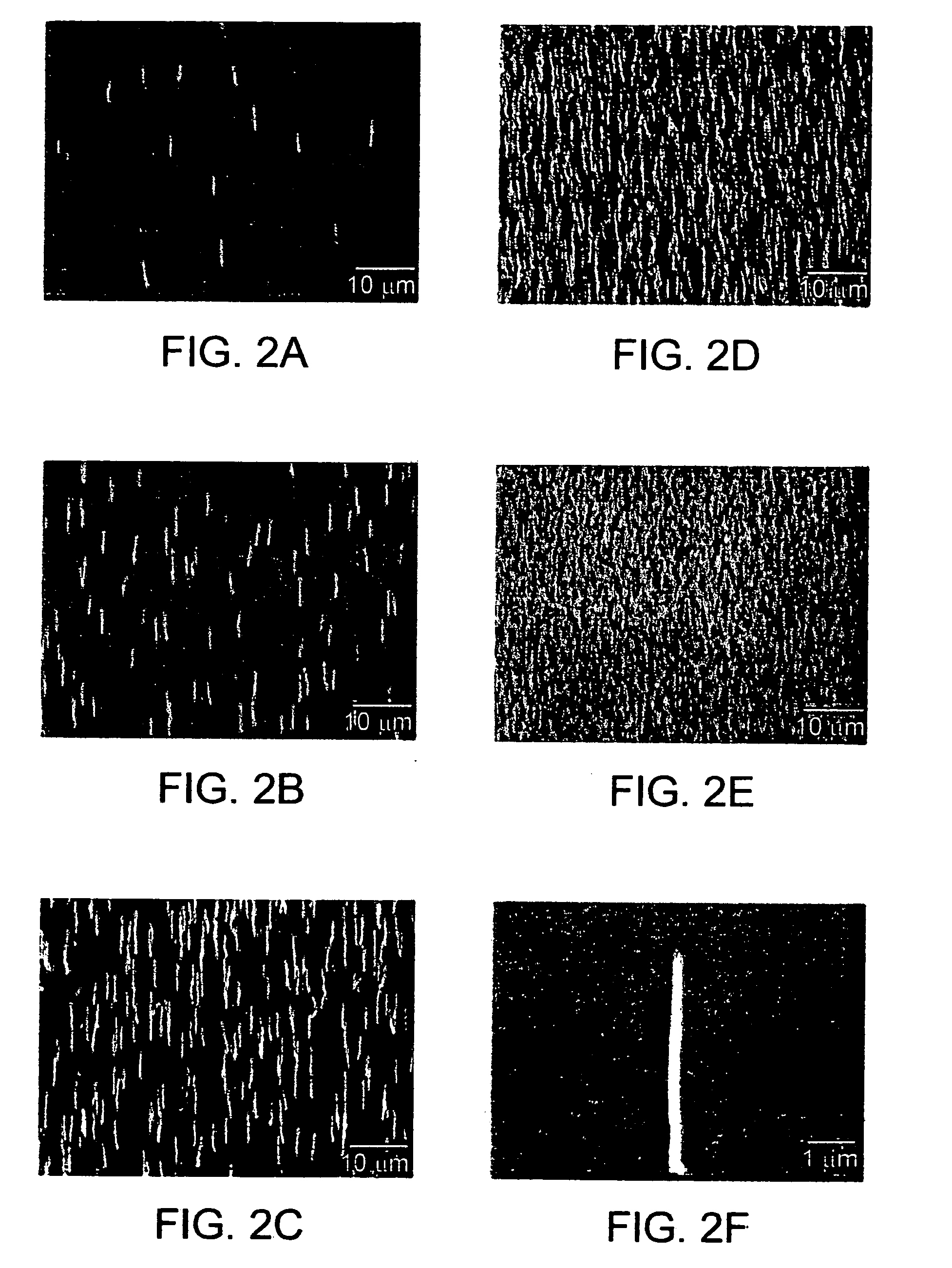Carbon nanotube nanoelectrode arrays
a carbon nanotube and nanoelectrode technology, applied in the field of microelectrode arrays, can solve the problems of inability to achieve the use of cnts for nanoelectrode arrays, poor detection limits and low signal-to-noise ratio, and inadequate number of electrodes per unit area of neas, etc., to achieve good electrical conductivity, wide useful potential range, and high aspect ratio
- Summary
- Abstract
- Description
- Claims
- Application Information
AI Technical Summary
Benefits of technology
Problems solved by technology
Method used
Image
Examples
example 1
Formation of Ni Microparticles Onto a Substrate By Current Electrochemical Deposition
[0142] The current electrochemical deposition is carried out on a two electrode system. The working electrode is prepared by sputtering a layer of chromium (Cr) onto a silicon (Si) wafer forming a flat, conductive and defect free surface. Gold plate is used as counter electrode. A bath solution of about 0.01 M nickel sulfate (NiSO4) and about 0.01 M boric acid (H3BO3) in double distilled water is prepared. The solution is weakly acidic. About 1 cm2 of the working electrode surface is exposed to the solution. The distance between the two electrodes is kept at about 1 cm. The chemicals are preferably reagent grade from Aldrich and used as received. A constant current pulse is applied by using a current source and a voltage source. Both the current source and the voltage source are controlled by a computer program. The current electrochemical deposition is at room temperature. The working electrode h...
example 2
Growth of CNTs Using PECVD
[0143] The substrate having Ni microparticles, as described in Example 1, is loaded into a PECVD system described by Z. F. Ren, et al., Science, 282, 1105 (1998); Z. P. Huang, et al., Appl. Phys. A: Mater. Sci. Process, 74, 387 (2002); and Z. F. Ren et al., Appl. Phys. Lett., 75, 1086 (1999), the contents of which are incorporated herein by reference in their entirety.
[0144] The pressure in the system is pumped down to about 2×10−6 Torr. About 160 standard cubic centimeter per minute (sccm) ammonia (NH3) gas is then introduced into the chamber and the temperature is increased by applying current on the tungsten (W) filament. About 100 Watts DC plasma is applied for about 10 to about 20 seconds first to pre-etch the nickel (Ni) microparticles, then about 40 sccm acetylene (C2H2) gas is introduced and the plasma intensity is increased to about 170 W for the aligned CNTs growth. The pressure during growth is kept at about 15 Torr. Both acetylene and ammonia...
example 3
Growth of Aligned CNTs Arrays
[0145] Ni microparticles are randomly electrodeposited on 1 cm2 Cr-coated silicon (Si) substrate by applying pulse current to the substrate in NiSO4 electrolyte solution. The size and the site density of the Ni microparticles are controlled by the amplitude and the duration of the pulse current. CNTs growth is performed in the plasma enhanced chemical vapor deposition (PECVD) system at temperature of 650° C. for 8 minutes with 160 sccm ammonia (NH3) gas and 40 sccm acetylene (C2H2) gas with a total pressure of 15 Torr and plasma intensity of 170 Watts. The CNTs are about 8 μm in length and about 100 nm in diameter. The average spacing between nanotubes is about 10 μm that corresponds to a site density of 106 cm−2.
PUM
| Property | Measurement | Unit |
|---|---|---|
| size | aaaaa | aaaaa |
| current density | aaaaa | aaaaa |
| current density | aaaaa | aaaaa |
Abstract
Description
Claims
Application Information
 Login to View More
Login to View More - R&D
- Intellectual Property
- Life Sciences
- Materials
- Tech Scout
- Unparalleled Data Quality
- Higher Quality Content
- 60% Fewer Hallucinations
Browse by: Latest US Patents, China's latest patents, Technical Efficacy Thesaurus, Application Domain, Technology Topic, Popular Technical Reports.
© 2025 PatSnap. All rights reserved.Legal|Privacy policy|Modern Slavery Act Transparency Statement|Sitemap|About US| Contact US: help@patsnap.com



